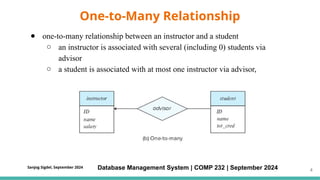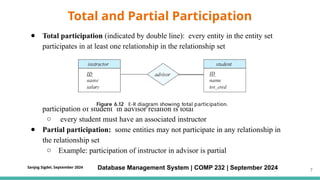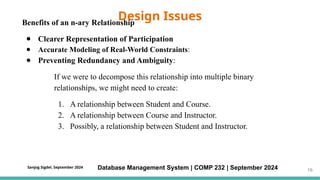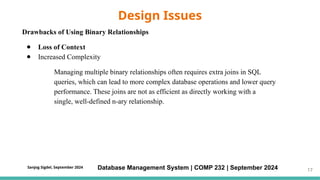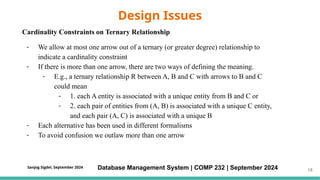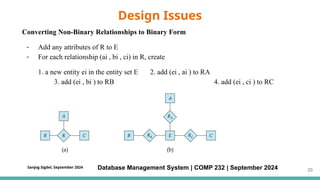COMP232 DBMS Lecture 5 - Database Design (1).pptx
- 1. Database Management System [COMP 232, Credit: 3, September 2024] Sanjog Sigdel, Lecturer, DoCSE Kathmandu University
- 2. Course Contents 1. Introduction: Database Systems Applications, Database System versus File systems, View of Data, Database Languages, Database Users and Administrators, Transaction Management, Database Architecture. [3 Hrs] 2. Database Design: Design Process, Entity Relationship Model, Constraints, Keys, Entity-Relationship Diagram, Design Issues, Weak Entity Sets, Extended E-R features, Design of an E-R Database Schema, Reduction of an E-R Schema to tables. [6 Hrs.] Database Management System | COMP 232 | September 2024 2 Sanjog Sigdel, September 2024
- 3. Recap of past lecture - Mapping Cardinality Constraint - Primary Key - Weak Entity Sets Database Management System | COMP 232 | September 2024 3 Sanjog Sigdel, September 2024
- 4. ● one-to-many relationship between an instructor and a student ○ an instructor is associated with several (including 0) students via advisor ○ a student is associated with at most one instructor via advisor, One-to-Many Relationship Database Management System | COMP 232 | September 2024 4 Sanjog Sigdel, September 2024
- 5. ● In a many-to-one relationship between an instructor and a student, ○ an instructor is associated with at most one student via advisor, ○ and a student is associated with several (including 0) instructors via advisor Many-to-One Relationship Database Management System | COMP 232 | September 2024 5 Sanjog Sigdel, September 2024
- 6. ● An instructor is associated with several (possibly 0) students via advisor ● A student is associated with several (possibly 0) instructors via advisor Many-to-Many Relationship Database Management System | COMP 232 | September 2024 6 Sanjog Sigdel, September 2024
- 7. ● Total participation (indicated by double line): every entity in the entity set participates in at least one relationship in the relationship set participation of student in advisor relation is total ○ every student must have an associated instructor ● Partial participation: some entities may not participate in any relationship in the relationship set ○ Example: participation of instructor in advisor is partial Total and Partial Participation Database Management System | COMP 232 | September 2024 7 Sanjog Sigdel, September 2024
- 8. ER Diagram Example Database Management System | COMP 232 | September 2024 8 Sanjog Sigdel, September 2024 Department Offers Courses teaches enrollm ent advisor Professor Courses major faculty
- 9. 9
- 10. Design choices: 1. Should a concept be modeled as an entity or an attribute? 2. Should a concept be modeled as an entity or a relationship? 3. Identifying relationships: Binary or ternary? Aggregation? Constraints in the ER Model: 4. A lot of data semantics can (and should) be captured. 5. But some constraints cannot be captured in ER diagrams. Design Issues Database Management System | COMP 232 | September 2024 10 Sanjog Sigdel, September 2024
- 11. Use of entity sets vs. attributes - Use of phone as an entity allows extra information about phone numbers. - Should phone be an attribute of Employees or an entity (connected to inst_phone by a relationship)? - Depends upon the use we want to make of phone information, and the semantics of the data: - If we have several phone per employee, phone must be an entity (since attributes cannot be set-valued) Design Issues Database Management System | COMP 232 | September 2024 11 Sanjog Sigdel, September 2024
- 12. Use of entity sets vs. relationship sets Possible guideline is to designate a relationship set to describe an action that occurs between entities Design Issues Database Management System | COMP 232 | September 2024 12 Sanjog Sigdel, September 2024
- 13. Binary versus n-ary relationship sets Although it is possible to replace any nonbinary (n-ary, for n > 2) relationship set by a number of distinct binary relationship sets, a n-ary relationship set shows more clearly that several entities participate in a single relationship. e.g., attribute date as attribute of advisor or as attribute of student Design Issues Database Management System | COMP 232 | September 2024 13 Sanjog Sigdel, September 2024
- 14. Example: Ternary Relationship ● Entities: ○ Student (e.g., student_id, name) ○ Course (e.g., course_id, course_name) ○ Instructor (e.g., instructor_id, name) ● Ternary Relationship: ○ Enrolled captures that a student is enrolled in a course taught by a specific instructor. In this case, the relationship is best modeled as a ternary relationship because all three entities are directly connected in a meaningful way that depends on all of them. Design Issues Database Management System | COMP 232 | September 2024 14 Sanjog Sigdel, September 2024
- 15. Benefits of an n-ary Relationship ● Clearer Representation of Participation: ● Preventing Redundancy and Ambiguity: If we were to decompose this relationship into multiple binary relationships, we might need to create: 1. A relationship between Student and Course. 2. A relationship between Course and Instructor. 3. Possibly, a relationship between Student and Instructor. Design Issues Database Management System | COMP 232 | September 2024 15 Sanjog Sigdel, September 2024
- 16. Benefits of an n-ary Relationship ● Clearer Representation of Participation ● Accurate Modeling of Real-World Constraints: ● Preventing Redundancy and Ambiguity: If we were to decompose this relationship into multiple binary relationships, we might need to create: 1. A relationship between Student and Course. 2. A relationship between Course and Instructor. 3. Possibly, a relationship between Student and Instructor. Design Issues Database Management System | COMP 232 | September 2024 16 Sanjog Sigdel, September 2024
- 17. Drawbacks of Using Binary Relationships ● Loss of Context ● Increased Complexity Managing multiple binary relationships often requires extra joins in SQL queries, which can lead to more complex database operations and lower query performance. These joins are not as efficient as directly working with a single, well-defined n-ary relationship. Design Issues Database Management System | COMP 232 | September 2024 17 Sanjog Sigdel, September 2024
- 18. Cardinality Constraints on Ternary Relationship - We allow at most one arrow out of a ternary (or greater degree) relationship to indicate a cardinality constraint - If there is more than one arrow, there are two ways of defining the meaning. - E.g., a ternary relationship R between A, B and C with arrows to B and C could mean - 1. each A entity is associated with a unique entity from B and C or - 2. each pair of entities from (A, B) is associated with a unique C entity, and each pair (A, C) is associated with a unique B - Each alternative has been used in different formalisms - To avoid confusion we outlaw more than one arrow Design Issues Database Management System | COMP 232 | September 2024 18 Sanjog Sigdel, September 2024
- 19. Converting Non-Binary Relationships to Binary Form - In general, any non-binary relationship can be represented using binary relationships by creating an artificial entity set. - Replace R between entity sets A, B and C by an entity set E, and three relationship sets: 1. RA, relating E and A 2. RB, relating E and B 3. RC, relating E and C - Create a special identifying attribute for E Design Issues Database Management System | COMP 232 | September 2024 19 Sanjog Sigdel, September 2024
- 20. Design Issues Database Management System | COMP 232 | September 2024 Converting Non-Binary Relationships to Binary Form - Add any attributes of R to E - For each relationship (ai , bi , ci) in R, create 1. a new entity ei in the entity set E 2. add (ei , ai ) to RA 3. add (ei , bi ) to RB 4. add (ei , ci ) to RC 20 Sanjog Sigdel, September 2024
- 21. Reduction to Relational Schemas Database Management System | COMP 232 | September 2024 ● Entity sets and relationship sets can be expressed uniformly as relation schemas that represent the contents of the database. ● A database which conforms to an E-R diagram can be represented by a collection of schemas. ● For each entity set and relationship set there is a unique schema that is assigned the name of the corresponding entity set or relationship set. ● Each schema has a number of columns (generally corresponding to attributes), which have unique names. 21 Sanjog Sigdel, September 2024
- 22. Reduction to Relation Schemas Database Management System | COMP 232 | September 2024 A strong entity set reduces to a schema with the same attributes student(ID, name, tot_cred) A weak entity set becomes a table that includes a column for the primary key of the identifying strong entity set section ( course_id, sec_id, sem, year ) Example 22 Sanjog Sigdel, September 2024
- 23. Representation of Entity Sets with Multivalued Attributes Database Management System | COMP 232 | September 2024 - A multivalued attribute M of an entity E is represented by a separate schema EM - Schema EM has attributes corresponding to the primary key of E and an attribute corresponding to multivalued attribute M - Example: Multivalued attribute phone_number of instructor is represented by a schema: inst_phone= ( ID, phone_number) - Each value of the multivalued attribute maps to a separate tuple of the relation on schema EM For example, an instructor entity with primary key 22222 and phone numbers 456-7890 and 123-4567 maps to two tuples: (22222, 456-7890) and (22222, 123-4567) 23 Sanjog Sigdel, September 2024
![Database
Management System
[COMP 232, Credit: 3, September 2024]
Sanjog Sigdel,
Lecturer, DoCSE
Kathmandu University](https://image.slidesharecdn.com/comp232dbmslecture5-databasedesign1-250629162149-db9c5027/85/COMP232-DBMS-Lecture-5-Database-Design-1-pptx-1-320.jpg)
![Course Contents
1. Introduction: Database Systems Applications, Database System versus File systems,
View of Data, Database Languages, Database Users and Administrators, Transaction
Management, Database Architecture. [3 Hrs]
2. Database Design: Design Process, Entity Relationship Model, Constraints, Keys,
Entity-Relationship Diagram, Design Issues, Weak Entity Sets, Extended E-R
features, Design of an E-R Database Schema, Reduction of an E-R Schema to tables.
[6 Hrs.]
Database Management System | COMP 232 | September 2024 2
Sanjog Sigdel, September 2024](https://image.slidesharecdn.com/comp232dbmslecture5-databasedesign1-250629162149-db9c5027/85/COMP232-DBMS-Lecture-5-Database-Design-1-pptx-2-320.jpg)

